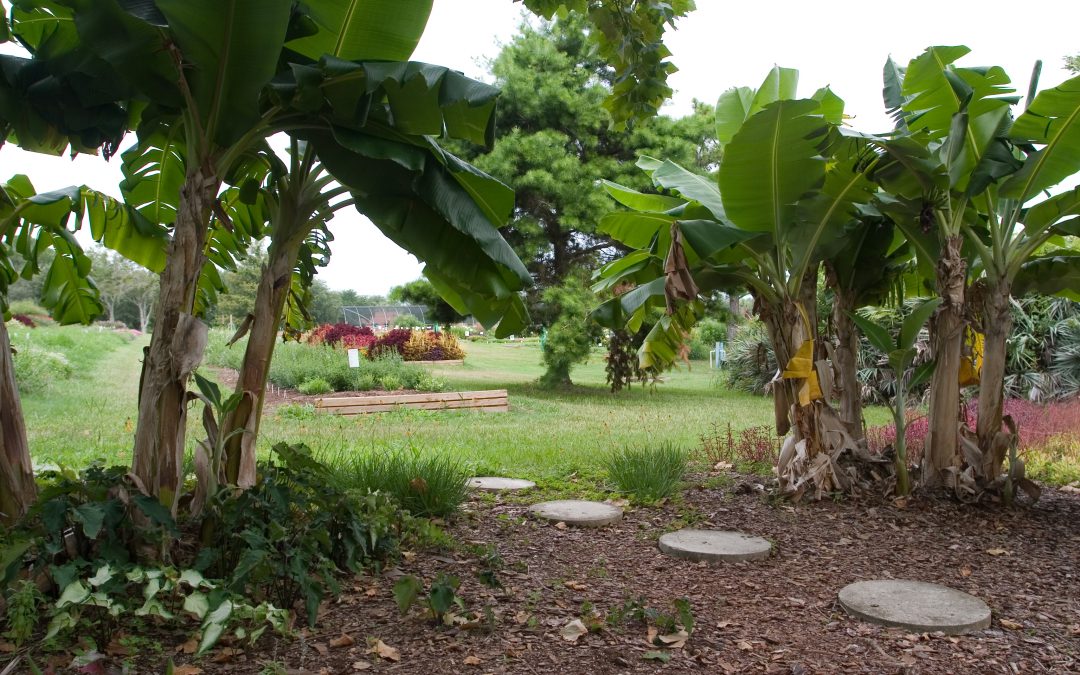
by Ray Bodrey | Feb 25, 2021
Bananas are a great choice for your landscape, whether as an edible fruit producer or simply as an ornamental, giving your space a tropical vibe.
Bananas are native to southeast Asia, however, grow well across Florida. Complementary plants that can be paired with bananas in the landscape are bird of paradise (banana relative), canna lily, cone ginger, philodendron, coontie, and palmetto palm, just to name some.
Bananas are very easy to manage during the warmer months. Bananas are water loving, and that’s putting it lightly. Planting in vicinity of an eave on your home is a good measure for site suitability. Roof rainwater will drastically increase the growth of the banana tree and decrease the need for supplemental irrigation. Banana trees will need full sun and high organic moist soils create the best environment. For nutrition, a seasonal one-pound application of 6-2-12 fertilizer is a good practice to sustain older trees. Young trees should be fertilized every two months for the first year at a rate of a half-pound.
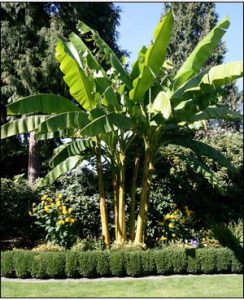
Musa basjoo is one of the most cold hardy banana varieties. Photo Credit: University of Florida/IFAS Extension
If there is a con to banana trees, it’s their cold hardiness. Some varieties fair well and others some not so much. ‘Dwarf Cavendish’ (Musa acuminate) is a popular variety that is found in many garden centers in the state. It produces fruit very well, but it is not very cold hardy. ‘Pink Velvet’ (Musa velutina) produces fruit with a bright pink peel, but isn’t very cold hardy either. A couple of cold hardy ornamental varieties are the ‘Japanese Fiber’ (Musa basjoo) and ‘Black Thai’ (Musa balbisiana), which is by far the most cold hardy, with the ability to easily combat below freezing temperatures.
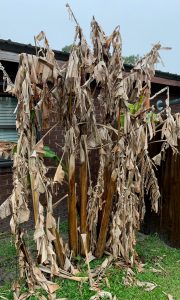
Freeze damage on a banana tree. Photo Credit: Ray Bodrey, University of Florida Extension – Gulf County
Regardless of cold hardiness, in many cases, banana trees will turn brown after freezing temperatures occur or even if the temperatures reach just above the freezing mark, but will bounce back in the spring. Until then, it’s important not to prune away the brown leaves or trunk skin. These leaves act as an insulator and help defend against freezing temperatures. Usually, the last freezing temperatures that may occur in the Panhandle are around the first of April. So, to be safe, pruning can begin by mid to late April. When pruning, be sure to be equipped with a sharp knife, gloves and work clothes. Banana trunk skin and leaves can be quite fibrous and the liquid from the tree can stain clothing and hands.
So, what’s the best variety of fruiting bananas? Most ornamental bananas do not produce tasty fruit. If you are looking for a production banana, ‘Lady Finger’, ‘Apple’, and ‘Ice Cream’ are popular varieties, but are better suited for the central and southern parts of the state.
For more information, contact your local county extension office.
Supporting information for this article can be found on the UF/IFAS Gardening Solutions website.
Also, for more information see the UF/IFAS EDIS publication, “Banana Growing in the Florida Home Landscape”, by Jonathan H. Crane and Carlos F. Balerdi.
UF/IFAS Extension is an Equal Opportunity Institution.
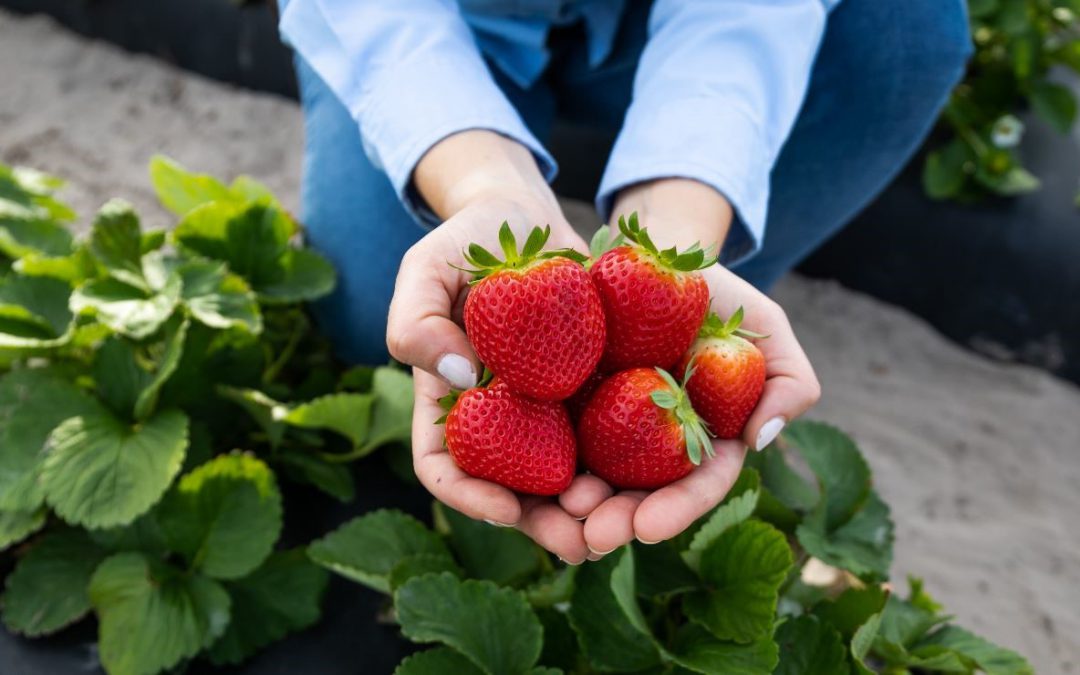
by Ray Bodrey | Nov 4, 2020
Who doesn’t like strawberries, right? Backyard gardeners grow these low-growing herbs throughout the state and there is a significant commercial industry too, as Florida’s climate is ideal for cool season production.
Strawberries like well-drained sandy soils, so they’re a perfect fit for many areas in the Panhandle. Strawberries should be planted in the months of October or November as the plants are quite cold hardy. Shorter days and temperatures between 50°F and 80°F are ideal for fruit development.
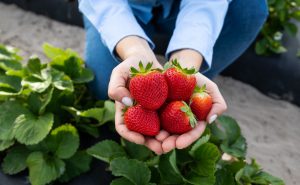
Photo Credit: Cristina Carriz, UF/IFAS
Strawberries are also very versatile. You can plant them in the ground, in raised beds or even containers. Transplants should be planted 12” to 18” apart, with 12” row spacing. For best results, use a rich soil balanced with compost and sandy soil and both fertilize and water regularly. Mixing in 2 ½ pounds of 10-10-10 fertilizer into a 10’ x 10’ bed space should be sufficient to start. A sprinkle of fertilizer applied monthly throughout the growing season should also help ensure a solid yield.
Berry production begins to ramp up roughly 90 days after planting, but plants will continue to produce throughout the spring. When the weather gets warmer, the plants start to expend energy into producing runners instead of fruit. These runners will be new fruit producing plants for next season.
Transplants can be purchased from most garden centers. There are many varieties on the market, but “Florida-Friendly” cultivars include “Sweet Charlie”, “Camarosa”, “Chandler”, “Oso Grande”, “Selva”, and “Festival”. “Camarosa” has proven to be the most productive variety in North Florida. Any of these varieties are capable of producing two pints of fruit per plant.
As stated earlier, Florida has a significant strawberry industry and UF/IFAS has a supporting role. The UF/IFAS Gulf Coast Research and Education Center (GCREC) is home to the Strawberry Breeding Program. Cultivars are developed by traditional means, for the Florida commercial industry on an 11,000+ acres research site. Appearance, shelf life, sweet flavor and disease resistance are just some of the areas of selected breading research that is conducted on site. There is also a white strawberry soon to be released!
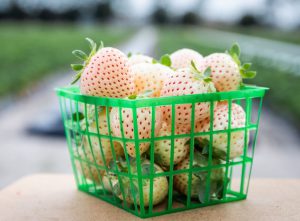
Photo Credit: Cristina Carriz, UF/IFAS
For more information, contact your local county extension office.
Supporting information for this article can be found at the website: https://gardeningsolutions.ifas.ufl.edu/plants/edibles/fruits/strawberries.html
UF/IFAS Extension is an Equal Opportunity Institution.
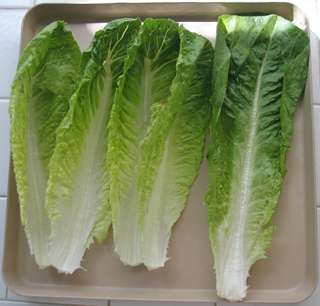
by Ray Bodrey | Oct 7, 2020
Who doesn’t enjoy a fresh, crisp bowl of salad? Lettuce happens to be a vegetable that is easily grown in Florida for fall & winter gardens. In Florida, four types of lettuce are commonly grown: crisphead, butterhead, leaf, & today’s topic, romaine.
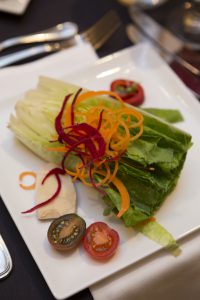
Photo courtesy of Tyler Jones, UF/IFAS.
An interesting, little known fact about romaine lettuce is that it was cultivated extensively by the Roman Empire. By the fourteenth century, the Catholic Hierarchy had moved from Rome to Avignon, France bringing their prized lettuce along with them. During this period, the plant was known as “Avignon” lettuce. In England, romaine is called “cos” lettuce named after the Greek islands from which the lettuce was originally distributed. Of course, in the U.S., the name we give, Romaine, refers to the time when it was grown extensively in the Roman Empire.
Romaine is grown both commercially and in backyard gardens across the state. Like all lettuce, this is a cool season vegetable. September through March is a generally the extent of the growing season. Romaine can be grown from seeds or by transplants. If you are going the seeding route, just remember these seeds are very small and should be sown shallow and in a tight pattern, with 12”-18” row spacing and a light sprinkle of soil over the top. Newly planted seeds may require burlap or straw to help retain soil moisture for successful germination. Once plants reach a few inches in height, rows can be thinned to where plants are 8” apart.
Romaine needs adequate soil moisture throughout the season. Mulching around plants to retain moisture and adding a complete fertilizer such as 8-8-8 will help ensure a good yield. Lettuce is vulnerable to the usual suspects of garden pests. However, gardening in cooler months helps combat that threat.
Romaine lettuce is fun and rewarding to harvest, as well. You can pick a few leaves off a plant or harvest the entire head.
For more information, contact your local UF/IFAS County Extension office.
Supporting information for this article can be found in the UF/IFAS EDIS publication, “Romaine – Lactuca sativa L.” by James M. Stephens, Emeritus Extension Vegetable Crops Specialist, UF/IFAS: https://edis.ifas.ufl.edu/mv125
UF/IFAS Extension is an Equal Opportunity Institution.

by Ray Bodrey | Sep 28, 2020
 Ray Bodrey is in his fifth year as the Gulf County Extension Director. Ray is originally from the “Watermelon Capital of the World” – Cordele, GA, where he grew up on a family row crop farm. His extension areas are Agriculture, Natural Resources (including Sea Grant programs) and Horticulture. He holds degrees in Biology, (B.S. 2006, Georgia Southern University); Agricultural Leadership, (M., 2011, University of Georgia) and Soil & Water Sciences, (M.S. 2015, University of Florida). Ray is also beginning his second year of the PhD program in UF’s Soil & Water Sciences Department. His research focus concerns strategies for building soil health after timber to pasture land conversion.
Ray Bodrey is in his fifth year as the Gulf County Extension Director. Ray is originally from the “Watermelon Capital of the World” – Cordele, GA, where he grew up on a family row crop farm. His extension areas are Agriculture, Natural Resources (including Sea Grant programs) and Horticulture. He holds degrees in Biology, (B.S. 2006, Georgia Southern University); Agricultural Leadership, (M., 2011, University of Georgia) and Soil & Water Sciences, (M.S. 2015, University of Florida). Ray is also beginning his second year of the PhD program in UF’s Soil & Water Sciences Department. His research focus concerns strategies for building soil health after timber to pasture land conversion.
Ray’s horticulture programming efforts include extension series library talks on lawn and gardening topics, teaching courses for the Master Gardener Volunteer Program, as well as teaching pesticide license exam review and GI-BMP trainings. Before coming to UF/IFAS Extension, Ray was a member of the Water Quality Program of the University of Georgia Marine Extension Service – Georgia Sea Grant Program for eight years. As a Marine Resource Specialist, Ray’s extension and research centered on nonpoint source pollution activity in coastal surface waters.
When not juggling extension hats, Ray enjoys fishing, hunting, gardening and really, just being in the great outdoors. Growing skyscraper sunflowers, raised bed gardening, composting and caring for citrus and peach trees are just some of the fun times had around his homestead.
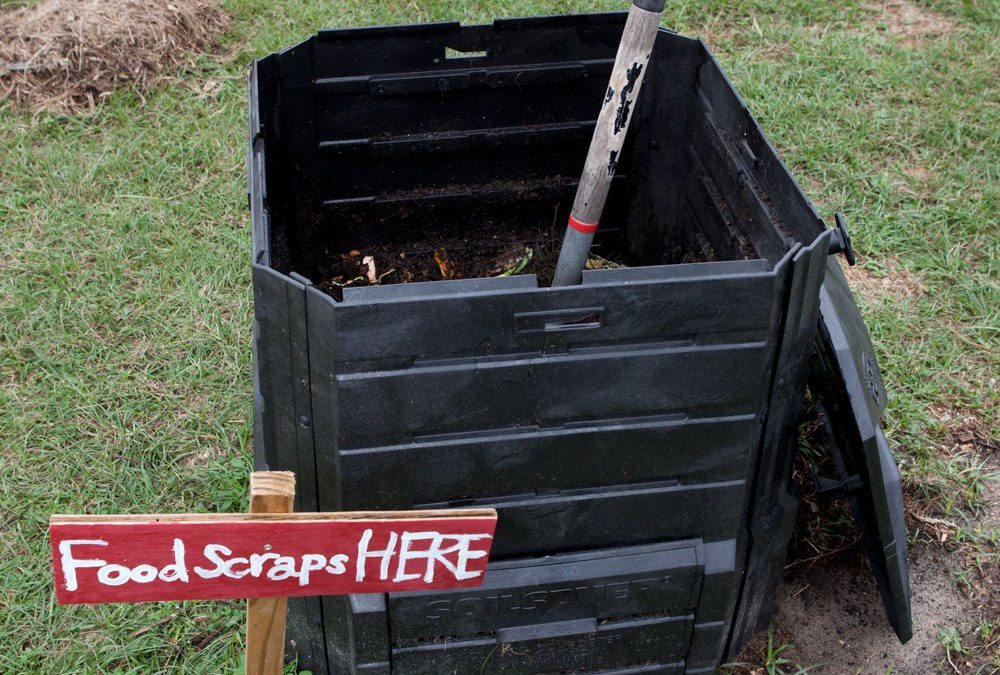
by Ray Bodrey | Aug 24, 2020
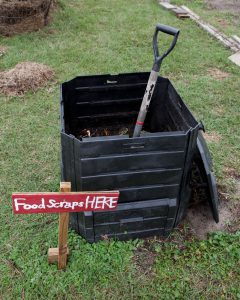
Figure: Increase water holding capacity through home composting.
Credit: Tyler Jones, UF/IFAS Communications.
Water is a precious resource for Floridians, even if the last couple of months of rainfall may make you think otherwise. As home gardeners, we should keep water conservation in mind.
Wasting water now may cause restrictions in the future, as basic water needs of a growing population outpace capacity. Of course, we all hope that’ll never happen, but it is possible.
As we start planning for our fall vegetable garden, let’s think about conserving water usage. We can start by putting our “plant biology” cap on. A great way to save water is to plant fast growing, early-maturing vegetables. The strategy, of course, is the sooner a plant matures the less water it will need.
Gardening periods in Florida vary, too. Thus, there are broad choices of planting dates for many vegetables. For Panhandle gardeners, the current trend has shown dry periods in the spring, but adequate rainfall in summer months. Usually with the seasonal change to fall, soil moisture holding capacity is not a great struggle in Panhandle. However, much of our soils consist of coarse sandy particles, which are not ideal for water holding capacity. Amending garden soils with organic materials such as compost, manures, and cover crops, will help the soil hold water better.
Selecting the right irrigation method is also a great way to conserve water. Overhead sprinkling is not ideal for most gardening applications. This method wastefully projects water into areas between rows, outside of root zones and allows for much evaporation loss. Drip irrigation can help solve these issues, by concentrating water directly to the root system. IFAS research has estimated an 80% reduction in water usage when utilizing a drip system.
If drip irrigation isn’t a method you’re interested in, overhead watering the garden thoroughly twice weekly is an acceptable alternative. Remember, there’s a limit to how much water plants can use. Excess water can cause runoff and consistent heavily saturated soils may promote root rot. Mulching also ranks highly among water conservation practices, by allowing the soil to hold more moisture. Examples of mulch types include hay, straw, leaves or plastic.
Supporting information for this article can be found at the UF/IFAS gardening solutions website.
For planting information, please see the Florida Vegetable Gardening Guide.













